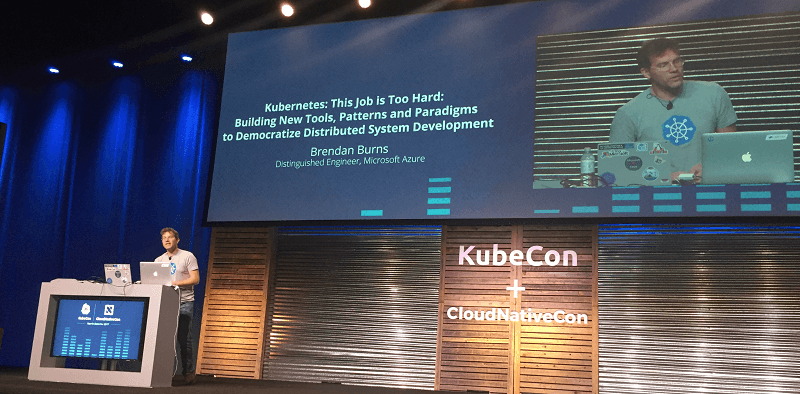4-minute read time
Last week, the Kubernetes community came together at KubeCon, with the goal of making it easier than ever to use containers to modernize existing applications and manage new applications to drive digital transformation.
Here are some of the top themes from the event:
Kubernetes growth is stellar.
The conference has grown +2x in a single year, from less than 2,000 attendees in 2016 to more than 4,200 attendees in 2017. Kubernetes has established a solid leadership position as a container orchestrator, with Mesos, Docker, and Pivotal all announcing their support.
The community values diversity.
Cloud Native Computing Foundation (CNCF), who organized the event, announced the Diversity Scholarship Fund of more than $250,000, with contributions from Microsoft, Google, and AWS. This fund, which was the largest yet for a Linux Foundation event, enabled 103 Diversity recipients to attend the conference this year. Microsoft’s Jessie Frazelle, Kris Nova, and Michelle Noorali (pictured below) were on the Diversity board.

Istio made a splash.
Istio is an open platform that provides a uniform way to connect, manage, and secure microservices. Istio supports managing traffic flows between microservices, enforcing access policies, and aggregating telemetry data, all without requiring changes to the microservice code. Check out Istio in this demo by Brian Redmond.
Make Kubernetes boring.
A big theme at the conference was “make Kubernetes boring.” A lot of customers think “Kubernetes is magic and solves all things” but according to Brendan Burns’ keynote “this job is too hard!” The Kubernetes project has one goal in mind: to make infrastructure boring by investing in new tools, patterns, and paradigms. All the magic is what you build on top with service meshes, functions-as-a-service, observability, etc.

Service meshes were a hot topic.
Though it’s still a new concept, it is all about making it easier to build cloud native applications. We saw a new service mesh called Conduit from the folks at Buoyant. Conduit was designed to be incredibly fast and lightweight, highly performant, and secure, with real-world Kubernetes and gRPC use cases in mind.
Kata containers stood out.
Kata is as a new container format with isolation benefits and works seamlessly with Docker containers and Kubernetes. Learn more about it here.
Any other favorite moments from KubeCon? Let us know in the comments.
Azure + Kubernetes announcements

Microsoft also announced several Kubernetes community projects and partnerships that extend what customers can do with Kubernetes and Azure, and the ease with which users can do it with new projects for serverless containers and Kubernetes-native DevOps. Building on recent Kubernetes investments, like joining the CNCF and contributing the Draft and Brigade projects, the Azure team announced several new Kubernetes projects and partnerships at KubeCon. Top announcements included:
Manage serverless containers using Kubernetes with the Virtual Kubelet: A new version of the Kubernetes connector, the Virtual Kubelet, can be used by customers to target Azure Container Instances (ACI) or any equivalent runtime.
Democratize the development of distributed systems with Metaparticle. Brendan Burns unveiled Metaparticle, a standard library for cloud native applications on Kubernetes.
Kubernetes-native DevOps: new dashboard and visualization tool for pipelines: The same team that brought you Helm, Draft, and Brigade delivered again, announcing an open source reporting dashboard and visualization tool for Brigade pipelines called Kashti (“kawsh-tee” — or कश्ती, which is Hindi for kayak, dinghy, or small boat) built as a Kubernetes service.
Partners enhance Kubernetes support for Azure and Windows Server Containers: Two new collaborations with Heptio and Tigera.
Connect your Kubernetes applications (and more) to Azure services with Open Service Broker API: Microsoft announced a preview of the Open Service Broker for Azure (OSBA), an implementation of the Open Service Broker API for Azure services.
Learn more about managed Kubernetes for Azure Container Service (AKS) and try it for free here.
